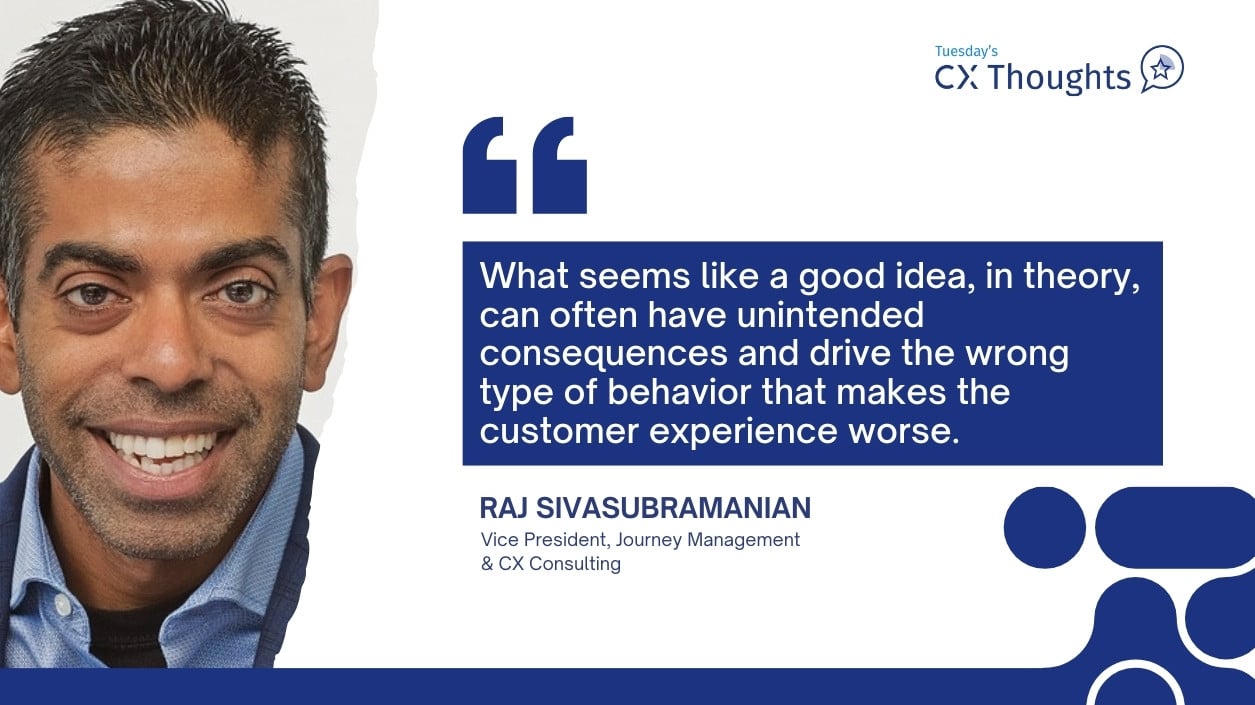
What seems like a good idea, in theory, can often have unintended consequences and drive the wrong type of behavior that makes the customer experience worse.
Metrics have become a polarizing topic in the customer experience space, and there is a lot of debate about which CX metric is best. Net Promoter Score (NPS) is one of the most widely adopted CX metrics, but it has a growing list of detractors, and many organizations prefer other CX metrics like Customer Satisfaction (CSAT) or Customer Effort Score (CES). Every year, some analyst or consultant promotes a better new CX metric that addresses the shortcomings of those three.
The problem with this debate is that it misses the fundamental problem with CX metrics: the way in which they are utilized. One of the big mistakes most organizations make is setting performance goals and targets against CX metrics. It doesn’t matter which metric you use, if you choose to measure performance based on survey-based metrics, you are undermining the metric’s value. And doing so has negative consequences for frontline employees, customers, and organizations overall.
Implications for Frontline Employees
It has become a common practice for organizations to use CX metrics like NPS or CSAT to measure the performance of frontline employees. The issue with this approach is that a customer’s perception of their experience is influenced by a myriad of factors, some of which are not directly within the control of the employee being measured.
For example, a customer could contact support because they are unhappy about a company policy they disagree with, but the agent they contact has no authority to change the policy. When an employee feels like they have done everything within their remit to resolve a situation but know that they will receive a poor survey score anyway, it can be very demotivating. Employees will begin to question the credibility of the metric and are more likely to churn.
Implications for Customers
The negative impact on employees can trickle down and hurt customers in a number of ways. For one, demotivated employees are less likely to provide good service. Employees seeking to beat what they perceive to be an unfair system can take actions that directly harm customers, such as not taking on difficult cases or transferring calls to other departments so a potentially bad score isn’t attributed to them.
Even in situations when there is no issue and service meets customer needs, connecting performance to CX metrics can lead to annoyances for customers. A common example is a service provider telling a customer at the end of an interaction to look out for a survey and that it’s really important for their job that they get the highest score.
Providing feedback shouldn’t be a burden on customers; it should be something they choose to do. When faced with an employee telling you their job depends on a score, many customers will reluctantly go out of their way to take a survey they might not have taken otherwise, and their feedback might be artificial.
There can also be more subtle 2nd order effects on customers. Let me share a personal anecdote that is somewhat related. My wife and I started hosting on Airbnb a few years ago, and fully committed ourselves to delivering great experiences for our guests. Our efforts paid off and we achieved Superhost status which has helped elevate the visibility of our listings.
There are a few factors that determine superhost eligibility, one of which is your average ratings from customer reviews. Our reviews have all been 5 stars and very positive, but this year we had a few 4 star reviews due to concerns guests had that were completely out of our control.
Much like with Uber, a 4 star review on Airbnb is unfortunately a bad thing for hosts which most guests don’t realize. (Issues with this system is a topic for another day.) These 4 star reviews dropped our rating in early December to just above the cutoff for Superhost status, with the next Superhost review scheduled for January first.
Keeping Superhost status in the new year was more valuable to me as a host than any bookings this month, so I decided it wasn’t worth the risk of one more 4 star review and decided not to accept any new reservation requests in December. This hurt me a little but also hurts Airbnb and their customers as my decision took a popular guest favorite off the market in a key tourist area during a peak travel period.
While using reviews as a way to measure host performance does make sense in theory, this example does illustrate the potential downstream implications for customers when performance is measured on things that are outside of an individual’s control.
Implications for the Organization
When employee or customer behavior is altered because of targets based on CX metrics, organizations also suffer by not getting valuable constructive feedback. When scores get inflated because everyone is asking for high scores (or the system penalizes anything less than a 5 star review), organizations will think they are doing a better job than they really are. Feedback that could be used to improve the experience will never come in, and disenchanted customers will just leave instead.
But what about setting performance targets against CX metrics at the the organizational and individual levels? Even that can be problematic because of the fact that customer sentiment is complex and influenced by many factors. Improving company wide NPS requires a holistic approach. Still, I have seen too many organizations treat CX targets like revenue targets and divide up a goal across different teams like in the waterfall chart below.
This approach never works because survey-based metrics don’t have this level of precision so what inevitably happens is teams spend more time arguing about the merits of the targets vs taking actions to improve the experience. In some extreme cases, the pressure to hit a target can even cause teams to try to improve a score through manipulation of survey results, which again defeats the purpose of trying to improve the customer experience.
The Better Approach – CX Metrics as a North Star
So you might be questioning the purpose of CX Metrics given the difficulty of setting goals against them. How are we supposed to measure performance of CX efforts? A better approach is to look at your survey-based CX metrics as a North Star. It should be a guide driving alignment around where you need to focus to improve the customer experience.
Then feedback from the surveys that derive the metric should be analyzed to determine what actions should be taken to improve the customer experience. And performance goals should then be set against completing those actions.
This simple shift from measuring performance against the tangible actions that drive a metric vs measuring against the metric itself will drive improved CX while avoiding all of the pitfalls described in this article.
Customer experience metrics should serve as a guiding light, not a rigid performance target. When organizations shift their focus from chasing higher survey scores to driving real improvements in customer interactions, they create a healthier, more sustainable approach to CX management.
Instead of pressuring employees or manipulating survey results, companies should leverage CX metrics as diagnostic tools, identifying areas for improvement and taking meaningful action to enhance the customer journey.
Treating NPS, CSAT, and CES as indicators rather than scorecards is a great way to develop a culture of continuous improvement, where frontline employees feel empowered, customers provide genuine feedback, and leadership teams gain insights into what truly impacts customer satisfaction.
In the long run, this approach leads to better experiences, stronger relationships, and more authentic business growth—a far more valuable outcome than simply hitting a numerical target.







